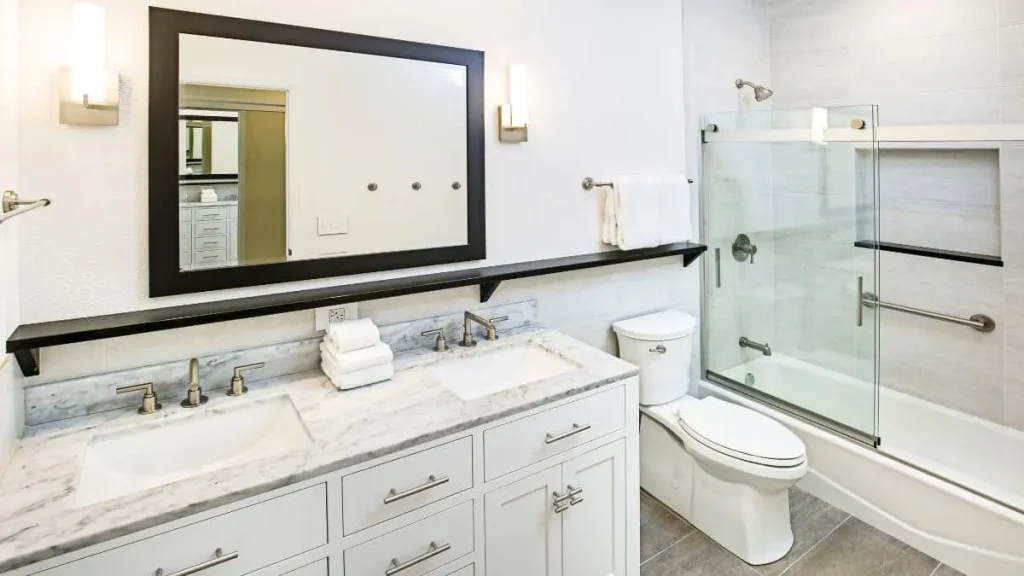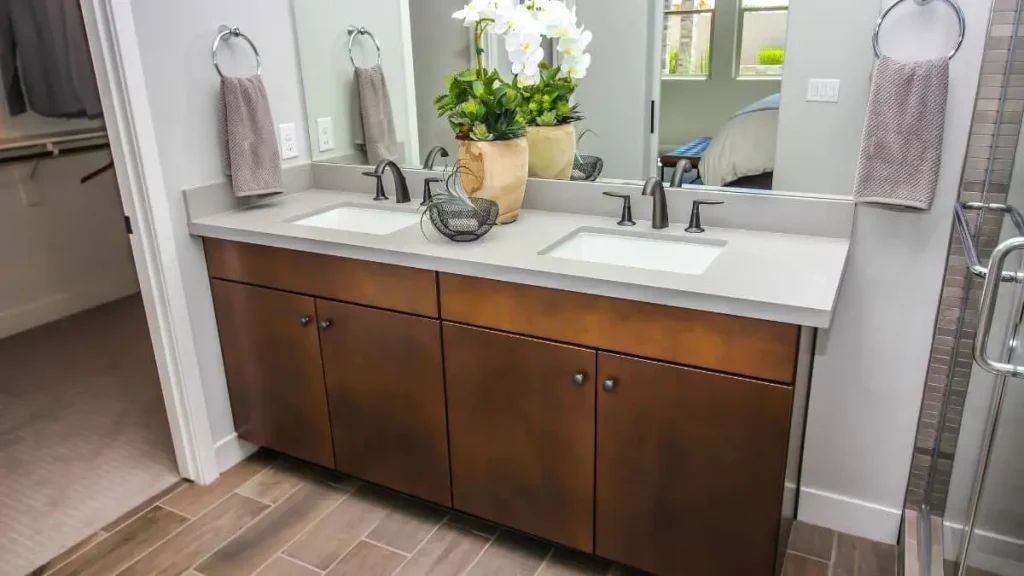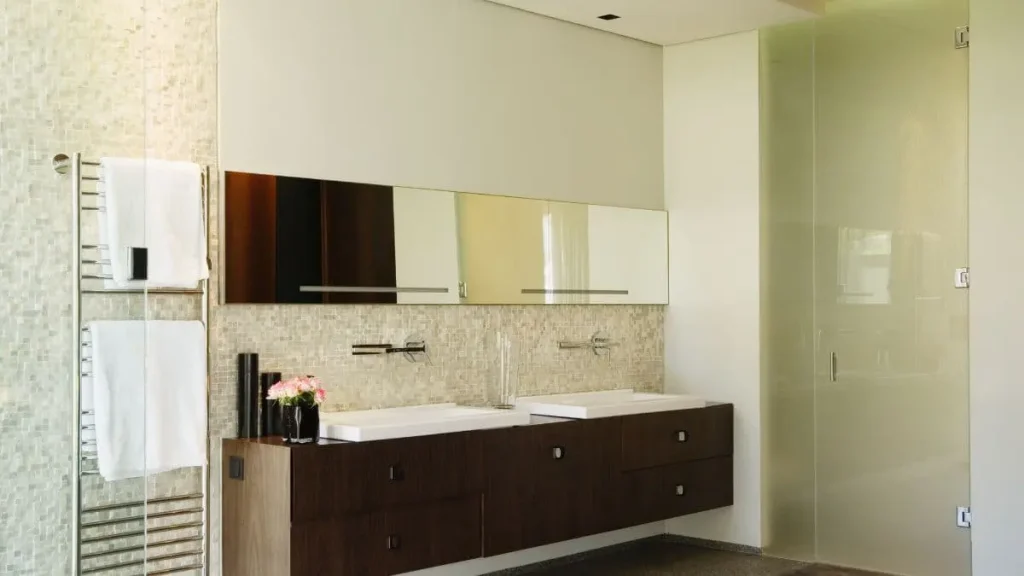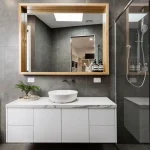When it comes to bathroom design, space can often feel like a luxury. Many of us dream of having a spacious, well-organized bathroom, but when reality hits, we’re often faced with a tight squeeze.
One creative solution that’s gaining popularity is the use of two single vanities in one bathroom. Imagine having two separate sink areas, each with its own storage and style, without taking up too much extra room. It’s not just a practical choice; it’s also a design statement.
How two single vanities in one bathroom can maximize your space and elevate your bathroom’s functionality and aesthetics. Whether you’re remodeling a small bathroom or looking to update a larger space, this approach offers a blend of efficiency and elegance that’s worth considering.
Benefits of Two Single Vanities

Enhanced Functionality
One of the biggest perks of installing two single vanities in one bathroom is the added functionality. Think about those busy mornings when everyone needs to get ready at the same time.
With two separate vanities, each person has their own space, reducing the morning rush and making the start of the day much smoother. It’s like having a personal sink and countertop for each user, eliminating the need to juggle around one shared space.
Design Flexibility
Having two single vanities opens up a world of design possibilities. Instead of being limited to a single, large vanity, you can choose two separate vanities that complement each other while reflecting your unique style.
Want one vanity with a modern finish and another with a classic look? No problem! This flexibility allows you to create a balanced and personalized bathroom design that suits your tastes and needs.
Visual Appeal
In terms of aesthetics, two single vanities in one bathroom can create a visually appealing, symmetrical look. If you place the vanities side by side, they can add a touch of modern elegance to your space.
Alternatively, if you’re working with a larger bathroom, positioning them at opposite ends of the room can create a balanced and sophisticated atmosphere. Either way, the result is a bathroom that feels both stylish and thoughtfully designed.
In summary, choosing two single vanities in one bathroom isn’t just about practicality; it’s also about enhancing your bathroom’s design and functionality. With separate sink areas, increased design options, and a sleek look, you’re well on your way to creating a space that’s both beautiful and efficient.
Space-Saving Strategies

When it comes to fitting two single vanities in one bathroom, thoughtful planning is key to making the most of your space. Here are some strategies to ensure you maximize every square inch without compromising on style or functionality:
Layout Considerations
Before diving into vanity selection, consider the layout of your bathroom. If your space is on the smaller side, placing the vanities on opposite walls can help balance the room and prevent it from feeling cramped.
For larger bathrooms, you might opt for side-by-side vanities to create a more open and symmetrical look. Visualizing different layouts through sketches or design software can help you determine the best placement for your needs.
Vanity Sizes and Proportions
Choosing the right size for your vanities is crucial. For small bathrooms, look for compact vanities that offer efficient storage solutions without overwhelming the space.
On the other hand, if you have a more generous area, you can go for slightly larger vanities while still maintaining a sense of balance. Ensure that each vanity leaves enough room for comfortable movement and access to other bathroom features.
Incorporating Storage Solutions
One of the advantages of having two single vanities in one bathroom is the opportunity to incorporate ample storage. Look for vanities with built-in drawers, shelves, or cabinets to keep your bathroom essentials organized.
For additional space-saving, consider floating vanities that free up floor area and give the room a more open feel. Utilizing vertical space with wall-mounted shelves or cabinets can also help you make the most of your storage options.
Recommended: How to Fit a Vanity Between Two Bathroom Walls
Design Ideas and Tips

Designing a bathroom with two single vanities allows for creative expression and personalized touches. Here are some design ideas and tips to help you achieve a stylish and functional bathroom:
Matching or Contrasting Styles
Decide whether you want your vanities to match or contrast with each other. Matching vanities can create a cohesive and streamlined look, while contrasting styles can add visual interest and character.
For instance, you might choose two vanities with different finishes—one in a sleek, modern gray and the other in a warm, classic wood. This approach not only highlights each vanity but also enhances the overall design of the room.
Color and Material Choices
The color and material of your vanities play a significant role in the bathroom’s aesthetic. Popular materials like quartz, granite, and marble offer durability and elegance, while wood can add warmth and texture.
For color, consider choosing shades that complement the bathroom’s overall color scheme. Neutral tones like white or gray are versatile and timeless, while bold colors can make a statement and add personality.
Lighting and Mirrors
Proper lighting is essential for both functionality and ambiance. Install fixtures above or around each vanity to ensure adequate illumination for daily tasks like shaving or applying makeup. Additionally, mirrors are a key element in bathroom design.
Consider large, framed mirrors that extend above both vanities or individual mirrors that match each vanity’s style. Good lighting and well-placed mirrors will enhance the functionality of your vanities and contribute to a polished, professional look.
Thoughtfully implementing these design ideas and tips, you can create a bathroom that’s not only functional but also beautifully tailored to your personal style. With two single vanities in one bathroom, you have the flexibility to design a space that meets your needs while reflecting your unique taste.
Practical Considerations
When installing two single vanities in one bathroom, there are several practical factors to keep in mind to ensure a smooth and successful project. Here’s what you need to consider:
Plumbing and Installation
One of the primary concerns with installing two single vanities is managing the plumbing. Each vanity will require its own set of plumbing connections, which can be a bit more complex than installing a single unit.
It’s crucial to work with a skilled plumber who can handle the additional pipes, drains, and water supply lines. Ensure that the plumbing layout is designed to accommodate both vanities efficiently, without causing disruptions to your bathroom’s functionality.
Budgeting and Costs
While two single vanities in one bathroom can enhance functionality and style, they can also impact your budget. The cost of two separate vanities, along with additional plumbing and installation expenses, can add up.
It’s essential to set a realistic budget that includes not only the vanities themselves but also any associated costs such as installation, plumbing adjustments, and potentially higher costs for countertop materials.
Look for ways to balance quality and cost by comparing different vanity options and considering cost-effective materials without compromising on durability.
Maintenance and Cleaning
Maintaining and cleaning two single vanities can be straightforward with a few simple practices. Ensure that both vanities are made of materials that are easy to clean and resistant to moisture and stains.
Regularly wipe down the surfaces and keep the storage areas organized to prevent clutter. Additionally, check the plumbing connections periodically for any leaks or issues. By staying on top of maintenance, you’ll keep both vanities looking and functioning their best for years to come.
Examples and Case Studies

Real-world examples can provide valuable insights and inspiration when considering two single vanities in one bathroom. Here are a few case studies that highlight successful implementations and design choices:
Before and After Transformations
Small Bathroom Upgrade:
- Before: A cramped bathroom with a single large vanity and limited storage.
- After: The installation of two compact single vanities on opposite walls, each with built-in storage. This layout not only opened up the space but also provided each user with their own sink and countertop area. The use of light colors and floating vanities enhanced the feeling of openness.
Luxury Master Bath:
- Before: An outdated master bathroom with an oversized double vanity that made the room feel crowded.
- After: Two stylish single vanities placed side by side with matching high-end finishes. This redesign created a balanced look and allowed for additional counter space on each side. Elegant mirrors and well-placed lighting fixtures completed the sophisticated upgrade.
Visual Inspiration
Contemporary Chic:
- Design: Two single vanities with sleek, white finishes and minimalist hardware. The vanities are paired with large, frameless mirrors and modern pendant lights, creating a clean and airy aesthetic.
- Impact: This setup emphasizes a contemporary look while offering ample storage and functionality.
Classic Elegance:
- Design: Two single vanities made of rich, dark wood with classic detailing. Each vanity is complemented by a decorative mirror and traditional sconces.
- Impact: The combination of luxurious materials and classic design elements adds warmth and sophistication to the bathroom.
These examples illustrate how two single vanities in one bathroom can be tailored to fit various styles and functional needs. By drawing inspiration from these transformations, you can envision how this approach might work in your own space, leading to a bathroom that’s both beautiful and practical.
Related Read: Why Extend Your Vanity Top Over the Toilet
Common Mistakes to Avoid

When installing two single vanities in one bathroom, it’s easy to overlook some important details. Here are some common mistakes to avoid to ensure your project runs smoothly and your bathroom turns out just as you envisioned:
Overcrowding the Space
One of the biggest pitfalls is making the bathroom feel cramped. It’s essential to measure your space carefully before purchasing or installing vanities. Ensure there’s enough room for movement between the two vanities and that they don’t obstruct other bathroom features like the door or shower.
To avoid overcrowding, opt for compact vanities if you’re working with a smaller bathroom and always leave adequate clearance around each unit.
Ignoring Plumbing Challenges
Installing two single vanities means doubling the plumbing requirements. A common mistake is underestimating the complexity of this task. Improperly managed plumbing can lead to leaks, inadequate water flow, or even costly repairs.
Be sure to hire a qualified plumber who can properly install and connect both vanities. Plan for potential plumbing adjustments and ensure that both vanities have easy access to necessary plumbing connections.
Neglecting Aesthetic Balance
Another mistake is failing to achieve a balanced look with your two vanities. If the vanities differ too much in style, size, or finish, they can create a disjointed appearance.
To maintain a cohesive design, choose vanities that complement each other or work with a designer to ensure that the overall look remains harmonious. Pay attention to details like mirror placement and lighting to enhance the visual balance of the space.
Overlooking Storage Needs
While two single vanities offer more storage potential, it’s easy to overlook how much storage each user actually needs. If the vanities have insufficient storage or poorly designed drawers and cabinets, the extra space might not be as beneficial as intended.
Assess your storage requirements and select vanities with adequate and practical storage solutions. Consider including additional shelving or cabinets if necessary to fully utilize the available space.
Forgetting Maintenance Considerations
Choosing materials that are hard to maintain or clean can lead to frustration down the line. For example, intricate finishes or porous surfaces might require more upkeep than simpler options.
When selecting your vanities, consider how easy they will be to clean and maintain. Opt for materials that are durable and resistant to moisture and stains to ensure long-lasting functionality and ease of care.
Being aware of these common mistakes and taking proactive steps to avoid them, you’ll set yourself up for a successful installation of two single vanities in one bathroom. This careful planning will help you create a space that’s both stylish and functional, enhancing your bathroom’s overall design and usability.
Conclusion
Incorporating two single vanities in one bathroom offers a perfect blend of functionality and style, transforming your space into a more efficient and elegant environment. By providing each user with their own dedicated sink area, you reduce congestion during busy times and enhance the overall usability of your bathroom.
This design choice not only maximizes space but also allows for greater flexibility in design. With careful planning, you can avoid common pitfalls and ensure that both vanities complement each other and fit seamlessly into your bathroom layout.
Practical considerations such as plumbing, budgeting, and maintenance are key to a successful implementation, ensuring that your remodel is both beautiful and practical.Ultimately, two single vanities in one bathroom can significantly elevate your daily routine and enhance your bathroom’s aesthetic appeal. By leveraging the benefits and tips outlined, you’re well on your way to creating a space that’s both functional and stylish. Embrace this design approach and enjoy a bathroom that truly meets your needs.



